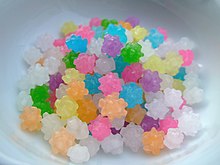Kompeitō
Kompeitō ( Japanese 金 平 糖 ) is a Japanese sweet made from sugar syrup.
etymology
Kompeitō is derived from the Portuguese word confeito for confectionery .
The usual spelling in Japanese is traditionally 金 was 糖 , which literally means “golden flat sugar”, although the characters were mainly chosen according to their phonetic equivalent to the pronunciation of the Portuguese term. Variants are 金 米糖 ("golden rice sugar") and 金 餅 糖 ("golden mochi sugar"). The opposite is the case with 糖 花 which means "sugar flower" - an Ateji , i. H. the characters describing the matter were given the reading Kompeitō , regardless of their actual pronunciation . In modern times , a purely phonetic notation is also used with the katakana コ ン ペ イ ト ー or hiragana こ ん ぺ い と う .
history
In the 16th century, the technique of making sweets was introduced to Japan by Portuguese traders. In April 1569, Luís Fróis gave this confectionary as a gift during his audience with Oda Nobunaga . Ihara Saikaku described the Kompeitō production in the customs description of Japanese merchants Nippon Eitaigura in 1688.
Since there was no infrastructure or technology for the preparation of sugar in Japan at that time and a lot of sugar is needed to prepare confeito , it was a rare and precious sweet. In the Meiji period , Kompeitō was already known as a normal Japanese sweet.
Manufacturing
Kompeitō usually has a diameter of 5 to 10 millimeters and is produced by wrapping a poppy seed several times - more rarely sesame seeds with sugar syrup. The seeds are rotated, heated and coated with syrup for several days until the characteristic ball with small mounds is created. The production normally takes 7–13 days and is still partly done by hand.
The formation of these mounds is attributed to the unevenness of the seeds used, which initially leads to an uneven covering of the seeds with the sugar syrup. Because areas with more sugar syrup solidify faster and the unevenness increases, the distinctive hills are created.
literature
- Richard Hosking: A Dictionary of Japanese Food: Ingredients and Culture . Tuttle Publ., Rutland, Vt. 1996, ISBN 0-8048-2042-2 , p. 84.
Web links
Individual evidence
- ↑ a b c d 金 平 糖 . In: 世界 大 百科 事 典 第 2 版 at kotobank.jp. Retrieved October 26, 2012 (Japanese).
- ↑ 金 米糖 ・ 金 平 糖 . In: 大 辞 林 第三版 at kotobank.jp. Retrieved October 26, 2012 (Japanese).
- ↑ Keiko Nakayama: Traditional Japanese Confectionery: The History of Wagashi. (No longer available online.) Kikkoman Corporation, archived from the original on October 26, 2012 ; accessed on October 12, 2012 (English): “Contact between Japan and the West began in 1543 when Portuguese arrived on the shores of Tanegashima, an island south of Kyushu. The Portuguese brought with them not only Christianity and firearms, but foods including European sweets. " Info: The archive link was automatically inserted and not yet checked. Please check the original and archive link according to the instructions and then remove this notice.
- ^ A b c Morikazu Toda: Interest in Form in Japan and the West . In: Proceedings of the First International Symposium for Science on Form . KTK Scientific Publishers, Tokyo 1986, p. 3–5 ( PDF ).

